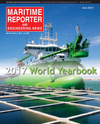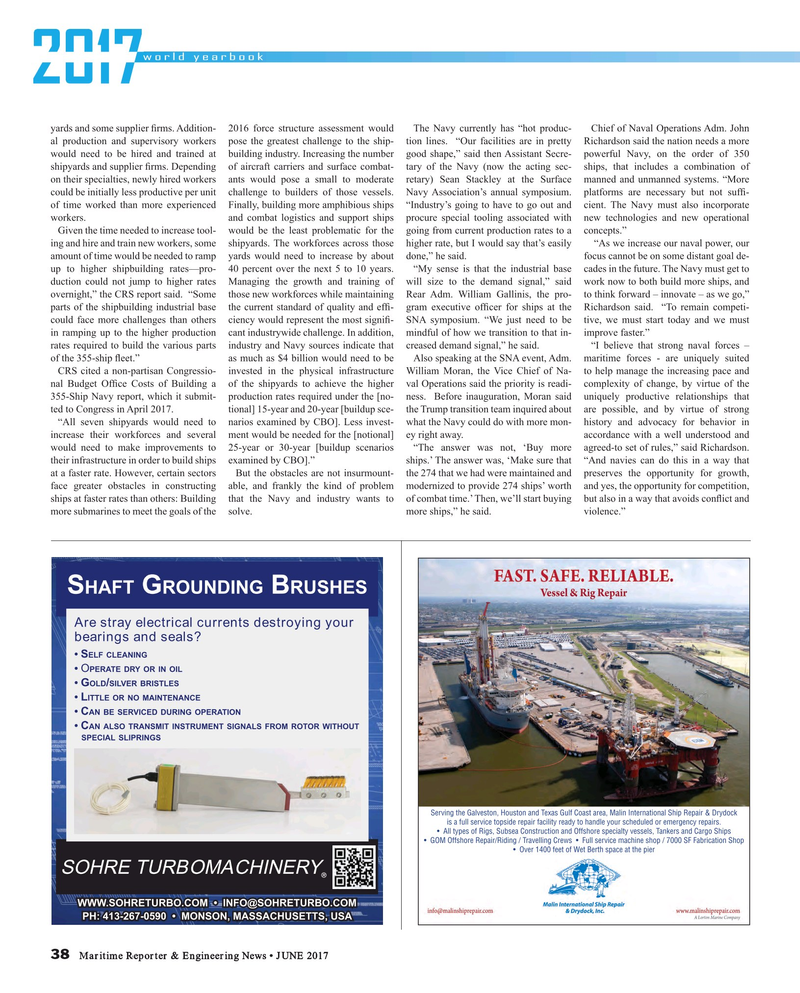
Page 38: of Maritime Reporter Magazine (June 2017)
U.S. Navy Quarterly
Read this page in Pdf, Flash or Html5 edition of June 2017 Maritime Reporter Magazine
world yearbook 2017 yards and some supplier ? rms. Addition- 2016 force structure assessment would The Navy currently has “hot produc- Chief of Naval Operations Adm. John al production and supervisory workers pose the greatest challenge to the ship- tion lines. “Our facilities are in pretty Richardson said the nation needs a more would need to be hired and trained at building industry. Increasing the number good shape,” said then Assistant Secre- powerful Navy, on the order of 350 shipyards and supplier ? rms. Depending of aircraft carriers and surface combat- tary of the Navy (now the acting sec- ships, that includes a combination of on their specialties, newly hired workers ants would pose a small to moderate retary) Sean Stackley at the Surface manned and unmanned systems. “More could be initially less productive per unit challenge to builders of those vessels. Navy Association’s annual symposium. platforms are necessary but not suf? - of time worked than more experienced Finally, building more amphibious ships “Industry’s going to have to go out and cient. The Navy must also incorporate workers. and combat logistics and support ships procure special tooling associated with new technologies and new operational
Given the time needed to increase tool- would be the least problematic for the going from current production rates to a concepts.” ing and hire and train new workers, some shipyards. The workforces across those higher rate, but I would say that’s easily “As we increase our naval power, our amount of time would be needed to ramp yards would need to increase by about done,” he said. focus cannot be on some distant goal de- up to higher shipbuilding rates—pro- 40 percent over the next 5 to 10 years. “My sense is that the industrial base cades in the future. The Navy must get to duction could not jump to higher rates Managing the growth and training of will size to the demand signal,” said work now to both build more ships, and overnight,” the CRS report said. “Some those new workforces while maintaining Rear Adm. William Gallinis, the pro- to think forward – innovate – as we go,” parts of the shipbuilding industrial base the current standard of quality and ef? - gram executive of? cer for ships at the Richardson said. “To remain competi- could face more challenges than others ciency would represent the most signi? - SNA symposium. “We just need to be tive, we must start today and we must in ramping up to the higher production cant industrywide challenge. In addition, mindful of how we transition to that in- improve faster.” rates required to build the various parts industry and Navy sources indicate that creased demand signal,” he said. “I believe that strong naval forces – of the 355-ship ? eet.” as much as $4 billion would need to be Also speaking at the SNA event, Adm. maritime forces - are uniquely suited
CRS cited a non-partisan Congressio- invested in the physical infrastructure William Moran, the Vice Chief of Na- to help manage the increasing pace and nal Budget Of? ce Costs of Building a of the shipyards to achieve the higher val Operations said the priority is readi- complexity of change, by virtue of the 355-Ship Navy report, which it submit- production rates required under the [no- ness. Before inauguration, Moran said uniquely productive relationships that ted to Congress in April 2017. tional] 15-year and 20-year [buildup sce- the Trump transition team inquired about are possible, and by virtue of strong “All seven shipyards would need to narios examined by CBO]. Less invest- what the Navy could do with more mon- history and advocacy for behavior in increase their workforces and several ment would be needed for the [notional] ey right away. accordance with a well understood and would need to make improvements to 25-year or 30-year [buildup scenarios “The answer was not, ‘Buy more agreed-to set of rules,” said Richardson. their infrastructure in order to build ships examined by CBO].” ships.’ The answer was, ‘Make sure that “And navies can do this in a way that at a faster rate. However, certain sectors But the obstacles are not insurmount- the 274 that we had were maintained and preserves the opportunity for growth, face greater obstacles in constructing able, and frankly the kind of problem modernized to provide 274 ships’ worth and yes, the opportunity for competition, ships at faster rates than others: Building that the Navy and industry wants to of combat time.’ Then, we’ll start buying but also in a way that avoids con? ict and more submarines to meet the goals of the solve. more ships,” he said. violence.”
S G BHAFT ROUNDING RUSHES
Are stray electrical currents destroying your bearings and seals?
?S ELF CLEANING ?O PERATE DRY OR IN OIL ?G / OLD SILVER BRISTLES ?L ITTLE OR NO MAINTENANCE ?C AN BE SERVICED DURING OPERATION ?C AN ALSO TRANSMIT INSTRUMENT SIGNALS FROM ROTOR WITHOUT
SPECIAL SLIPRINGS
Serving the Galveston, Houston and Texas Gulf Coast area, Malin International Ship Repair & Drydock is a full service topside repair facility ready to handle your scheduled or emergency repairs. s

 37
37

 39
39
